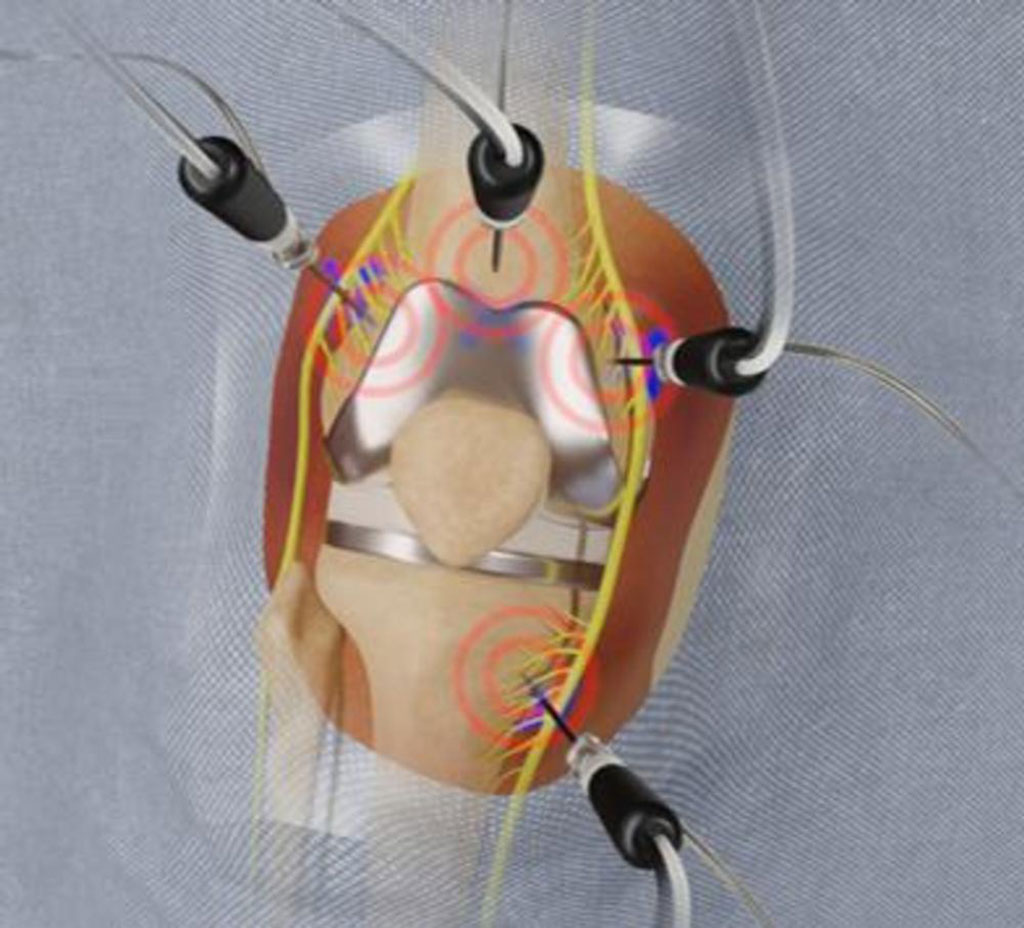Cooled RFA Relieves Pain Following Knee Replacement
|
By HospiMedica International staff writers Posted on 06 Dec 2021 |

Image: The cooled radiofrequency ablation (C-RFA) procedure (Photo courtesy of Dr. Felix Gonzalez/ RSNA)
A new study suggests cooled radiofrequency ablation (C-RFA) offers long-term relief for chronic and debilitating pain after knee replacement surgery.
Researchers at Emory University (Atlanta, GA, USA) conducted a study involving 21 patients who experienced persistent and chronic pain following total knee replacement, without any underlying hardware complications; all of the patients had failed conservative care. For the study, the patients filled out clinically validated questionnaires to assess pain severity, stiffness, functional activities of daily living, and use of pain medication before and after the C-RFA procedure.
Follow-up outcome scores were collected up to one year after the procedure. The questionnaire results showed that the patients experienced, on average, a statistically significant improvement in quality of life, with both pain and stiffness scores improving dramatically. No major complications were seen, and no patients required repeat treatment, surgical revision, or other interventions. The study was presented at the annual meeting of the Radiological Society of North America (RSNA), held during November-December 2021 in Chicago (IL, USA).
“The procedure's long-term relief gives it a major advantage over cortisone injections, which offer on average only about three months of pain relief. It's very encouraging that up to a year out these patients have such significant pain relief and a better quality of life,” said lead author Felix Gonzalez, MD. “With a larger propagating heat wave, you can account for the differences in nerve anatomy from patient to patient because of a larger treatment zone; treating a larger zone increases the effectiveness of the procedure.”
The C-RFA procedure involves insertion of an introducer needle under local anesthesia that targets specific nerve locations around the knee. A probe is then guided through the introducers. The tip of the probe imparts low voltage RFA to the deep sensory nerves around the knee. Water circulating through the system allows for a greater dissipation of heat from the tip of the probe.
Related Links:
Emory University
Researchers at Emory University (Atlanta, GA, USA) conducted a study involving 21 patients who experienced persistent and chronic pain following total knee replacement, without any underlying hardware complications; all of the patients had failed conservative care. For the study, the patients filled out clinically validated questionnaires to assess pain severity, stiffness, functional activities of daily living, and use of pain medication before and after the C-RFA procedure.
Follow-up outcome scores were collected up to one year after the procedure. The questionnaire results showed that the patients experienced, on average, a statistically significant improvement in quality of life, with both pain and stiffness scores improving dramatically. No major complications were seen, and no patients required repeat treatment, surgical revision, or other interventions. The study was presented at the annual meeting of the Radiological Society of North America (RSNA), held during November-December 2021 in Chicago (IL, USA).
“The procedure's long-term relief gives it a major advantage over cortisone injections, which offer on average only about three months of pain relief. It's very encouraging that up to a year out these patients have such significant pain relief and a better quality of life,” said lead author Felix Gonzalez, MD. “With a larger propagating heat wave, you can account for the differences in nerve anatomy from patient to patient because of a larger treatment zone; treating a larger zone increases the effectiveness of the procedure.”
The C-RFA procedure involves insertion of an introducer needle under local anesthesia that targets specific nerve locations around the knee. A probe is then guided through the introducers. The tip of the probe imparts low voltage RFA to the deep sensory nerves around the knee. Water circulating through the system allows for a greater dissipation of heat from the tip of the probe.
Related Links:
Emory University
Latest Critical Care News
- Precision Approach Improves Immunotherapy Effectiveness for ICU Patients with Sepsis
- Soft Robots Could Donate Their Heart to Humans
- Bioadhesive Strategy Prevents Fibrosis Around Device Implants on Peripheral Nerves
- Miniature Non-Invasive Robotic Catheters to Improve Infertility Treatments
- Stick-On Patch Monitors Baby's Movements In Utero
- EEG-Based AI Technology Accurately Diagnoses Alzheimer’s and Dementia
- Robot Lymphatic System Paves Way for Self-Powered Wearables and Machines
- Focused Ultrasound Technique Successfully Treats Pediatric Brain Cancer
- Nasal Drops Fight Brain Tumors Noninvasively
- AI Helps Optimize Therapy Selection and Dosing for Septic Shock
- Glowing Bacteria ‘Pills’ for Detecting Gut Diseases Could Eliminate Colonoscopies
- Skin-Permeable Polymer Patch Delivers Insulin Non-Invasively Through Skin
- Nanogel Technology Almost 100% Effective in Destroying Drug-Resistant Bacteria Within Hours
- Wearable Ultrasound Sensor Delivers Noninvasive Treatment Without Surgery
- Gel-Free ECG System to Transform Heart Health Diagnosis
- Biodegradable Patch Repairs Damaged Tissue After Heart Attack
Channels
Surgical Techniques
view channel
Minimally Invasive Surgery Proven Safe and Effective for Complex ‘Whipple’ Procedure
Tumors of the pancreatic head often require a highly complex operation known as pancreatoduodenectomy or the Whipple procedure. This surgery involves removing multiple structures and creating several internal... Read more
Catheter-Based Procedures Offer Less Invasive Option for Treatment of Valvular Disease
Valvular heart disease, caused by tight or leaky valves between heart chambers, affects up to 10% of older adults and leads to more than 120,000 deaths globally each year. Traditional open-heart surgery... Read morePatient Care
view channel
Revolutionary Automatic IV-Line Flushing Device to Enhance Infusion Care
More than 80% of in-hospital patients receive intravenous (IV) therapy. Every dose of IV medicine delivered in a small volume (<250 mL) infusion bag should be followed by subsequent flushing to ensure... Read more
VR Training Tool Combats Contamination of Portable Medical Equipment
Healthcare-associated infections (HAIs) impact one in every 31 patients, cause nearly 100,000 deaths each year, and cost USD 28.4 billion in direct medical expenses. Notably, up to 75% of these infections... Read more
Portable Biosensor Platform to Reduce Hospital-Acquired Infections
Approximately 4 million patients in the European Union acquire healthcare-associated infections (HAIs) or nosocomial infections each year, with around 37,000 deaths directly resulting from these infections,... Read moreFirst-Of-Its-Kind Portable Germicidal Light Technology Disinfects High-Touch Clinical Surfaces in Seconds
Reducing healthcare-acquired infections (HAIs) remains a pressing issue within global healthcare systems. In the United States alone, 1.7 million patients contract HAIs annually, leading to approximately... Read moreHealth IT
view channel
EMR-Based Tool Predicts Graft Failure After Kidney Transplant
Kidney transplantation offers patients with end-stage kidney disease longer survival and better quality of life than dialysis, yet graft failure remains a major challenge. Although a successful transplant... Read more
Printable Molecule-Selective Nanoparticles Enable Mass Production of Wearable Biosensors
The future of medicine is likely to focus on the personalization of healthcare—understanding exactly what an individual requires and delivering the appropriate combination of nutrients, metabolites, and... Read moreBusiness
view channel
Philips and Masimo Partner to Advance Patient Monitoring Measurement Technologies
Royal Philips (Amsterdam, Netherlands) and Masimo (Irvine, California, USA) have renewed their multi-year strategic collaboration, combining Philips’ expertise in patient monitoring with Masimo’s noninvasive... Read more
B. Braun Acquires Digital Microsurgery Company True Digital Surgery
The high-end microsurgery market in neurosurgery, spine, and ENT is undergoing a significant transformation. Traditional analog microscopes are giving way to digital exoscopes, which provide improved visualization,... Read more
CMEF 2025 to Promote Holistic and High-Quality Development of Medical and Health Industry
The 92nd China International Medical Equipment Fair (CMEF 2025) Autumn Exhibition is scheduled to be held from September 26 to 29 at the China Import and Export Fair Complex (Canton Fair Complex) in Guangzhou.... Read more









.jpg)



